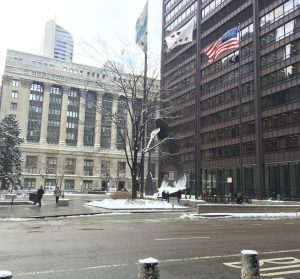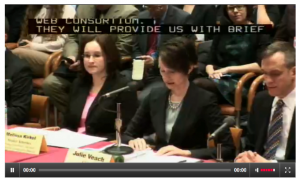Story by Keri Lynch
Photo credits: City of Chicago-Department of Environment
More than 20,000 plants and countless birds and bees live 11 stories above the busy city streets and sidewalks of Downtown Chicago.  About 150 varieties of hearty and mostly native flowers, grasses and vines grow on this rooftop garden most residents have never seen. But the garden’s green impact is beginning to spread well beyond the Loop.
About 150 varieties of hearty and mostly native flowers, grasses and vines grow on this rooftop garden most residents have never seen. But the garden’s green impact is beginning to spread well beyond the Loop.
Funded through a $1.5 million settlement with Com Ed, the 20,300-square-foot City Hall rooftop garden is both a showcase and a pilot project for Mayor Daley’s efforts to encourage green building and design. Since its completion in 2001, the number of green roofs continues to grow.
“Seven years ago, it was a novel idea (green roofs),” said Mark Farina, spokesman for Chicago’s Department of Environment.
“Now there are over 300 green roofs in Chicago, in various stages. That’s how much we have grown.”
 Although it’s one of the highest-profile roof gardens in the world, access for the general public is very limited. This is partly due to the landmark status of the building, Farina said, which is not accessible to persons with disabilities, and also for security reasons.
Although it’s one of the highest-profile roof gardens in the world, access for the general public is very limited. This is partly due to the landmark status of the building, Farina said, which is not accessible to persons with disabilities, and also for security reasons.
Besides not having a fence, visitors must walk through a mechanical room to get onto the roof, after taking an elevator to the 10th floor and walking up another flight of stairs. Occasionally, the Department of Environment will arrange tours for small groups of 10 to 15 people with a guide, such as Farina.
“This is an elaborate green roof that gives us an idea what we can do elsewhere,” Farina said.
Currently, 60 percent of all roofs in Chicago are dark-colored, according to the city’s rooftop garden guide, and these surfaces absorb – or trap – heat. This raises the temperature of the surrounding area and requires more energy to heat and cool buildings. Urban areas are warmer than outlying areas due to this “heat island” effect, which also creates more smog.
The City Hall rooftop garden was designed to test its cooling effects, as part of an Urban Heat Island Initiative. Scientists monitor and compare temperatures from the City Hall side of the building to the black tar roof on the Cook County side of the building at 121 N. LaSalle St. Records show at least a 50-degree difference from a typical black roof, according to the Chicago’s Department of Environment.
In addition to energy savings, green roofs can help improve air quality and increase the life of regular roofs, Farina said. Water quality is also improved as the plants absorb rain water, keeping it from entering the stormwater system, from which Chicago gets its drinking water.
“Plus, it is less of a strain on our sewer system,” Farina said.
Water conservation is another benefit of green roofs, says Jason Longo of Gensler architecture firm, which designed the Center on Halsted at 3656 N. Halsted St. with a green roof and other green building elements. White reflective roofs are better than black tar roofs, Longo said, but green roofs are the best.
“Water conservation is a priority,” said Longo, who is working with the city to establish water conservation guidelines. “Water is being lost, rather than replenished.”
While green building practices may cost more initially, experts say it can easily be recouped by decreased operating costs, primarily for energy. Energy savings are estimated at $3,600 per year for City Hall due to the rooftop, according to the Department of Environment’s web site.
“Our project costs were 1.5 percent higher than regular building methods,” said Robert Kohl, chairman of the Center on Halsted. “It seems obvious that we will consume less energy.”
To encourage green building and roof design, the city has an expedited green permit program and provides some grants for residential and commercial green buildings.
“Of the 10,000 to 15,000 (building) permits per year, 800 were large projects and 50 of them were green,” said Erik Olsen, green projects administrator for the Chicago Department of Construction and Permits. “It’s less than 1 percent, but most people are not doing rehab or new construction every day.”
On his web site called GreenBean, Olsen tracks green buildings in the works – both private and public. Projects currently listed include office and residential high rise buildings, a science building at DePaul University, Morse Theater, Exelon headquarters and the Millennium Park Bike Station. Millennium Park is itself a green roof, built on top of an underground parking structure.
“We have 3 million square feet of green roofs – and growing,” said city spokesman Farina. “The mayor has a vision to bring the green (building) industry to Chicago and create jobs.”
flag as offensive | email this page | printer friendly version | 553 reads | add new comment
Categories:
City Life Eco & Environment Planning & Development Public






Be First to Comment